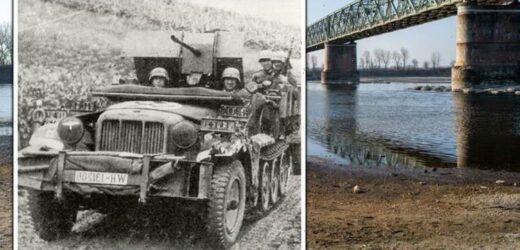Dunkirk: Military historian discusses World War Two shipwreck
We use your sign-up to provide content in ways you’ve consented to and to improve our understanding of you. This may include adverts from us and 3rd parties based on our understanding. You can unsubscribe at any time. More info
The exceptional drought in Italy caused a German military half-track vehicle re-surface from the River Po in Northern Italy. The decades-long search for this vehicle finally ended after it was found and recovered in Sermide, in the province of Mantua. The vehicle was pushed into the river by retreating German troops in April 1945 to prevent it from falling into the hands of US soldiers.
At the time, a British reconnaissance plane spotted the vehicle, however, the tank remained elusive despite repeated attempts to find it.
Samuele Bernini, a volunteer of the Second World War Museum in Sermide and Felonica, discovered the vehicle on March 25 after he spotted metal sheets sticking out of the sand.
Simone Guidorzi, the museum’s director said: “The half-track is an Sd.Kfz.11 model and weighs about seven tonnes.
“The Germans had abandoned several vehicles in this area, many were immediately recovered, but this one had ended up in deep water.


“Now we’re going to display it in our museum.”
Meanwhile, the researchers also discovered a wreck of a large boat that was sunk by Nazi bombing after it resurfaced from the bottom of the Po river.
The Sd.Kfz. 11m which stood for Sonderkraftfahrzeug, meaning special motorized vehicle, was a German half-track that was widely used in World War II.
The heavy vehicle was primarily used in transporting medium towed guns ranging from the 3.7 cm FlaK 43 anti-aircraft gun up to the 10.5 cm leFH 18 field howitzer.

The vehicle could carry up to eight soldiers, in addition to towing a gun or trailer.
The Sd.Kfz. 11 used a conventional ladder frame chassis design, and was powered by a front-mounted Maybach six-cylinder, water-cooled, 4.17 litres (254 cu in) HL 42 TRKM gasoline engine of 100 horsepower (100 PS).
The vehicle could reach speeds of up to 52.5 km/h (32.6 mph) and could ford water half a metre (1.6 ft) deep.
It was around this time that the Allied forces advanced into Northern Italy, after capturing Rome on 4th June 1944.
DON’T MISS:
Solar storm warning: NASA predicts direct Earth hit from ‘fast’ impact [REVEAL]
Australia battles ‘major outbreak’ as two die from virus [SPOTLIGHT]
Flurona: Patients with Covid and flu at higher risk of death [REPORT]


Codename Operation Grapeshot was the final Allied attack that took place during the final stages of WWII.
The 15th Allied Army Group attacked the Lombard Plain on 6 April 1945, with the battle ending on 2 May after German troops in Italy surrendered.
Before this, the Allie forces had launched their last major offensive on the Gothic Line in August 1944.
During this campaign, the British Eighth Army led by Lieutenant-General Oliver Leese attacked up the coastal plain of the Adriatic.
Meanwhile, the U.S. Fifth Army, led by Lieutenant General Mark Clark charged through the central Apennine Mountains
Source: Read Full Article

